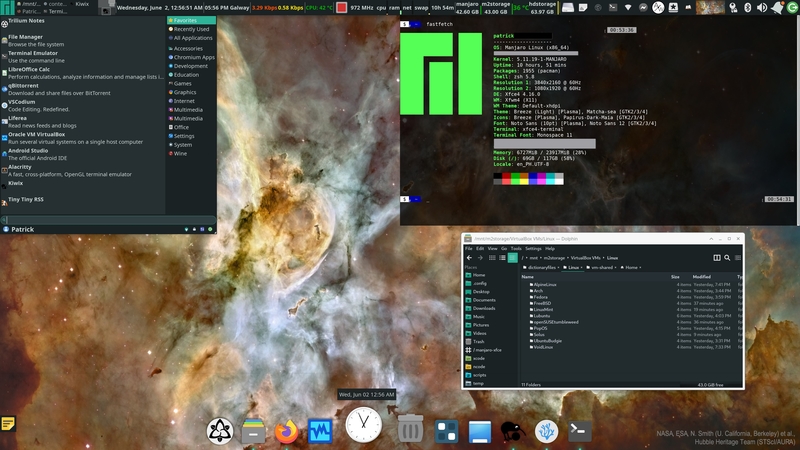The past two years has seen me rediscovering the power of Linux. The first Unix OS I ever used was Solaris back in college. Didn't really do much then besides the basics but I did see the usefulness of working primarily in the console or terminal. I remember attempting to use other flavors like Mandrake and SUSE and ended up being uninspired. Even the promising Ubuntu back then just felt unenjoyable to me that I effectively ignored this area of computing until I started learning git which would be many years later. So the majority of my computer user life has been spent inside Microsoft Windows.
Being a power user who loves to tinker with a lot of apps and features, it is not surprising why Windows was enough to sate my hunger. But the Linux of today has matured to the point that objectively speaking, there's not a single best distro anyone could point at. Linux distro debates resemble a holy war in the age of computers. There's plenty of good choices for anyone willing to get out of the Microsoft and Apple computer systems. I'd like to think that I've spent enough time already looking at the best candidates to confidently say that I've found my favorite Linux distro to use as my daily driver.

Reasons I Use Manjaro Linux
- Arch-based
- The AUR and ArchWiki. Seriously, this one bullet point should be enough to explain it all. Why not vanilla Arch? I just could not commit the time to set it up from the base. Manjaro had the most sensible defaults out of all the Arch-based distros I've tried while being the most stable.
- Top-notch KDE Plasma and XFCE
- Plasma is so beautiful in Manjaro. I used to be on KDE but multi-monitor setup inconveniences eventually forced me to finally appreciate the simply faster and more stable XFCE.
- Dolphin
- My preferred file manager from KDE which also works nicely on XFCE. It can be as powerful as you need it to be. Unfortunately, not many distros have it as default.
Other Distros I Would Have Chosen
- Fedora
- The cleanliness of Gnome and the stability of Fedora are truly great points. If pacman/AUR didn't exist, I would have gone this way. It's such a good distro that I almost wish I customarily used a second computer too just to have an excuse to work with Fedora daily.
- openSUSE Tumbleweed
- The only distro I've tried that matched KDE's caliber in Manjaro. And it somehow does feel like an OS for professional developers. If Fedora's DNF became annoying enough, I would go this way because Zypper is a nice package manager too.
- MX Linux
- The most powerful yet light distro I've ever come across is XFCE in MX Linux. It had served me many times as a rescue OS on USB flash drives. It's fast and it has all the tools you need preinstalled and at such a lightweight package with minimal footprint. Probably the only thing I dislike about it is the initial impression you get from the GUI design. (read: ugly)
Popular Distros I Will Likely Never Consider As My Daily Driver
- Ubuntu et al.
- Much like how we like our workplace to have some sort of personality, I like my distro not to look generic. All the Ubuntu flavors feel the same. Sure, the DE make them look different but under the hood it's all the same. I'm grateful though for its contributions to Linux's widespread adoption.
- Debian
- I admire its rock solid stability in those times I've used it in servers. But I'm not inclined to use Debian this way for reasons similar with Ubuntu.
- Linux Mint
- Its defining feature is the close resemblance of the UI to Windows and I appreciate that stated goal for Linux newcomers. But the Cinnamon desktop environment has never been to my liking. (Even though it should be because it's Irish and green.) I much prefer the design approach of Solus Budgie for this purpose. And Mint being Debian/Ubuntu-based well as you may have guessed, I prefer the rolling release cycle for distros.
This is not a knock on Ubuntu, Debian or Linux Mint. On the contrary, I think they deserve their popularity as top choices for Linux converts. There are also those for previous Mac users that are just as worthy like Zorin OS and elementary OS. The choice of a Linux distro is simply more often a matter of preference.
Manjaro is far from being a perfect distro and Linux is definitely not a perfect OS. Manjaro can sometimes be annoying with the constant update notifications and Linux still has a lot to work on to be a suitable replacement for Windows gamers. BSD and UNIX operating systems may also develop better in the coming years. There's simply no telling. But for now, Manjaro Linux best met my requirements for a powerful computer OS that is almost endlessly customizable while embracing the values in technology which I believe in.